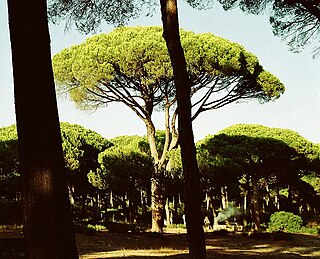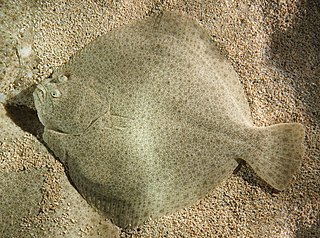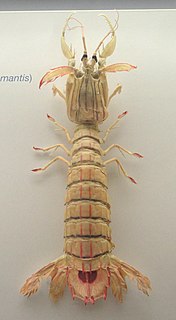
The Black Sea is a body of water, located in western Eurasia. Depending on the view, it can be classified as either the world's largest inland body of water, or a marginal sea. It is supplied by major rivers, principally the Danube, Dnieper, Southern Bug, Dniester, Don, and Rioni. The watersheds of many countries drain into the sea beyond the six that share its coast.

The Mediterranean Sea is a sea connected to the Atlantic Ocean, surrounded by the Mediterranean Basin and almost completely enclosed by land: on the north by Southern Europe and Anatolia, on the south by North Africa, and on the east by the Levant. Although the sea is sometimes considered a part of the Atlantic Ocean, it is usually referred to as a separate body of water. Geological evidence indicates that around 5.9 million years ago, the Mediterranean was cut off from the Atlantic and was partly or completely desiccated over a period of some 600,000 years during the Messinian salinity crisis before being refilled by the Zanclean flood about 5.3 million years ago.

The Strait of Gibraltar, also known as the Straits of Gibraltar, is a narrow strait that connects the Atlantic Ocean to the Mediterranean Sea and separates the Iberian Peninsula in Europe from Morocco in Africa.

A Mediterranean climate or dry summer climate is characterized by dry summers and mild, wet winters. The climate receives its name from the Mediterranean Basin, where this climate type is most common. Mediterranean climate zones are typically located along the western sides of continents, between roughly 30 and 45 degrees north and south of the equator. The main cause of Mediterranean, or dry summer climate, is the subtropical ridge which extends northwards during the summer and migrates south during the winter due to increasing north-south temperature differences.

The stone pine, botanical name Pinus pinea, also known as the Italian stone pine, umbrella pine and parasol pine, is a tree from the pine family (Pinaceae). The tree is native to the Mediterranean region, occurring in Southern Europe, The Palestinian Territories, Lebanon and Syria. It is also naturalized in North Africa, the Canary Islands, South Africa and New South Wales. The species was introduced into North Africa millennia ago, such a long time that it is essentially indistinguishable from being native.

Limonium is a genus of 120 flowering plant species. Members are also known as sea-lavender, statice, caspia or marsh-rosemary. Despite their common names, species are not related to the lavenders or to rosemary. They are instead in Plumbaginaceae, the plumbago or leadwort family. The generic name is from the Latin līmōnion, used by Pliny for a wild plant and is ultimately derived from the Ancient Greek leimon.

The turbot is a relatively large species of flatfish in the family Scophthalmidae. It is a demersal fish native to marine or brackish waters of the Northeast Atlantic, Baltic Sea and the Mediterranean Sea. It is an important food fish. Turbot in the Black Sea have often been included in this species, but are now generally regarded as separate, the Black Sea turbot or kalkan. True turbot are not found in the Northwest Atlantic; the "turbot" of that region, which was involved in the so-called "Turbot War" between Canada and Spain, is the Greenland halibut or Greenland turbot.

Caulerpa taxifolia is a species of seaweed, an alga of the genus Caulerpa native to the Pacific Ocean and Caribbean Sea. It is widely used ornamentally in aquariums, because it is considered attractive and neat in arrangement, and is easy to establish and care for. The alga has a stem (rhizome just above the seafloor. From this stem grow vertical fern-like pinnae, whose blades are flat like those of the yew, hence the species name taxifolia.

The Pelagie Islands, from the Greek πέλαγος, pélagos meaning "open sea", are the three small islands of Lampedusa, Linosa, and Lampione, located in the Mediterranean Sea between Malta and Tunisia, south of Sicily. To the northwest lie the island of Pantelleria and the Strait of Sicily. All three islands are part of the comune of Lampedusa. Geographically, part of the archipelago belongs to the African continent and it is an Italian maritime exclave in the Tunisian continental shelf; politically and administratively the islands fall within the Sicilian province of Agrigento and represent the southernmost part of Italy.

In biogeography, the Mediterranean Basin is the region of lands around the Mediterranean Sea that have a Mediterranean climate, with mild, rainy winters and hot, dry summers, which supports characteristic Mediterranean forests, woodlands, and scrub vegetation.

The European sprat, also known as bristling, brisling, garvie, garvock, Russian sardine, russlet, skipper or whitebait, is a species of small marine fish in the herring family Clupeidae. Found in European waters, it has silver grey scales and white-grey flesh. Specific seas in which the species occurs include the Irish Sea, Black Sea, Baltic Sea and Sea of the Hebrides. The fish is the subject of fisheries, particularly in Scandinavia, and is made into fish meal, as well as being used for human consumption. When used for food it can be canned, salted, breaded, fried, boiled, grilled, baked, deep fried, marinated, broiled, and smoked.

The Lessepsian migration is the migration of marine species across the Suez Canal, usually from the Red Sea to the Mediterranean Sea, and more rarely in the opposite direction. When the canal was completed in 1869, fish, crustaceans, mollusks, and other marine animals and plants were exposed to an artificial passage between the two naturally separate bodies of water, and cross-contamination was made possible between formerly isolated ecosystems. The phenomenon is still occurring today. It is named after Ferdinand de Lesseps, the French diplomat in charge of the canal's construction.

David Abulafia, is an English historian with a particular interest in Italy, Spain and the rest of the Mediterranean during the Middle Ages and Renaissance. He spent most of his career at the University of Cambridge, rising to become a professor at the age of 50. He retired in 2017 as Professor Emeritus of Mediterranean History. He is a Fellow of Gonville and Caius College, Cambridge. He was Chairman of the History Faculty at Cambridge University, 2003-5, and was elected a member of the governing Council of Cambridge University in 2008. He is visiting Beacon Professor at the new University of Gibraltar, where he also serves on the Academic Board. He is a visiting Professor at the College of Europe.

Mandragora officinarum is the type species of the plant genus Mandragora. It is often known as mandrake, although this name is also used for other plants. As of 2015, sources differed significantly in the species they use for Mandragora plants native to the Mediterranean region. The main species found around the Mediterranean is called Mandragora autumnalis, the autumn mandrake. In a broader circumscription, all the plants native to the regions around the Mediterranean Sea are placed in M. officinarum, which thus includes M. autumnalis. The names autumn mandrake and Mediterranean mandrake are then used. Whatever the circumscription, Mandragora officinarum is a perennial herbaceous plant with ovate leaves arranged in a rosette, a thick upright root, often branched, and bell-shaped flowers followed by yellow or orange berries.

Squilla mantis is a species of mantis shrimp found in shallow coastal areas of the Mediterranean Sea and the Eastern Atlantic Ocean: it is also known as "pacchero" or "canocchia". Its abundance has led to it being the only commercially fished mantis shrimp in the Mediterranean.
Eastern Mediterranean is a loose definition of the eastern approximate half, or third, of the Mediterranean Sea. It typically embraces all of that sea's coastal zones, referring to communities connected with the sea and land greatly climatically influenced, in Southeast Europe, northern Egypt and far Western Asia. It includes the southern half of Turkey's main region Anatolia, its smaller Hatay Province, the island of Cyprus, the Greek Dodecanese islands, the region of Syria, Lebanon, Gaza and Israel.

Patella ferruginea, commonly known as the ribbed Mediterranean limpet, is a species of sea snail, a true limpet, a marine gastropod mollusk in the family Patellidae, one of the families of true limpets. It is a large limpet, native to the western Mediterranean Sea, and although common in the past, it is now rare and restricted to only a few locations.

Mediterranean forests, woodlands, and scrub is a biome defined by the World Wide Fund for Nature. The biome is generally characterized by dry summers and rainy winters, although in some areas rainfall may be uniform. Summers are typically hot in low-lying inland locations but can be cool near colder seas. Winters are typically mild to cool in low-lying locations but can be cold in inland and higher locations. All these ecoregions are highly distinctive, collectively harboring 10% of the Earth's plant species.

The Mediterranean horse mackerel, also known as the Black Sea horse mackerel, horse mackerel, Mediterranean scad, common scad, or simply scad, is a species of mackerel in the family Carangidae found in the eastern Atlantic from Bay of Biscay to Mauritania, including the Mediterranean Sea. It is a benthopelagic, subtropical, marine fish that can reach up to 60 cm (24 in) in length. In the countries near the Mediterranean and Black Seas, it makes up a significant portion of fish catch, 54% of fish caught in the latter. Despite overfishing in the 1980s, catch numbers have leveled out and it is listed as least concern by the International Union for the Conservation of Nature.
Corticium candelabrum is a species of sponge in the order Homosclerophorida. It is native to the eastern Atlantic Ocean and the Mediterranean Sea where it inhabits the shallow sublittoral zone. The type locality is the Adriatic Sea.

















